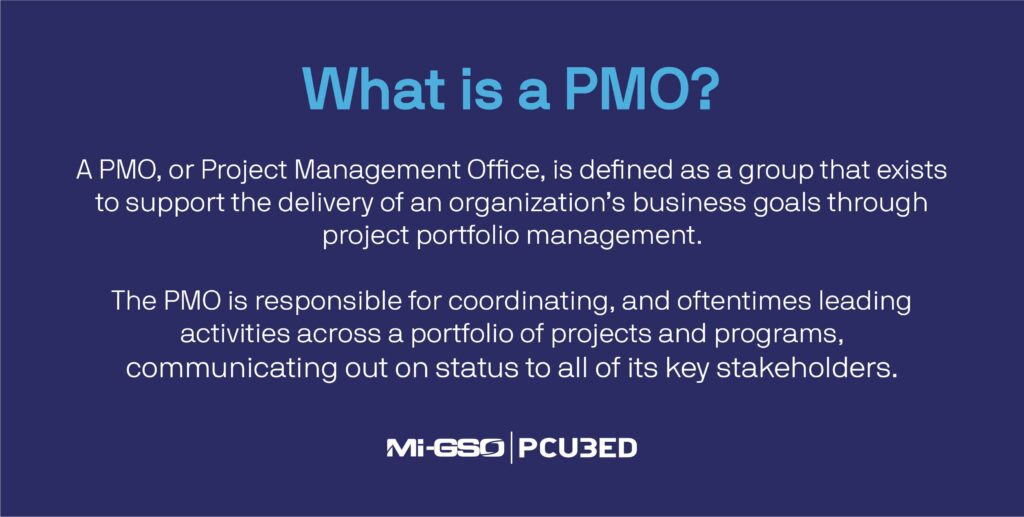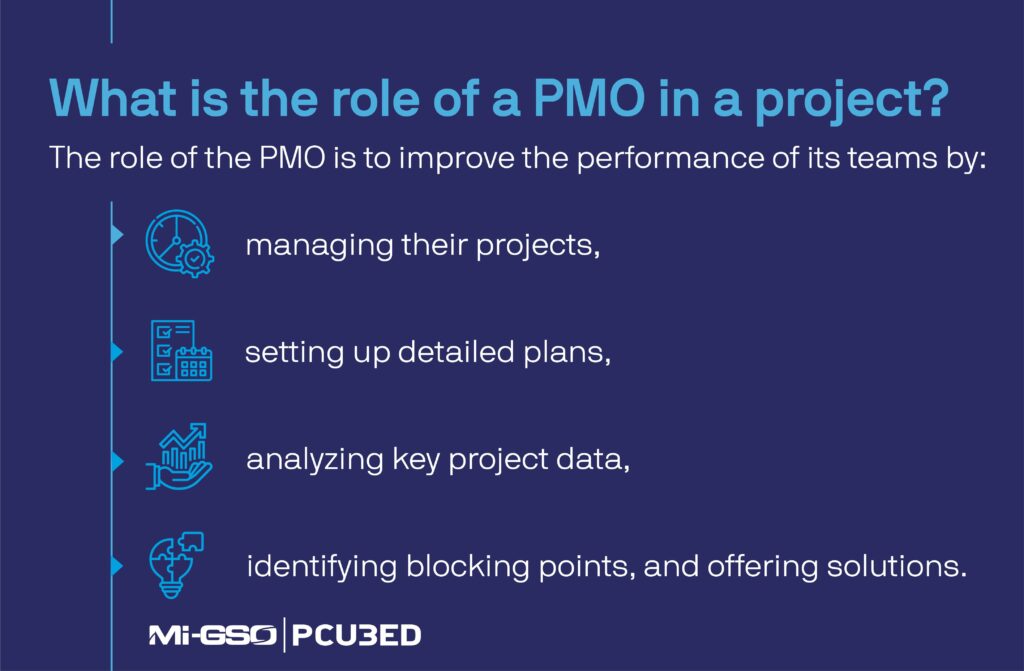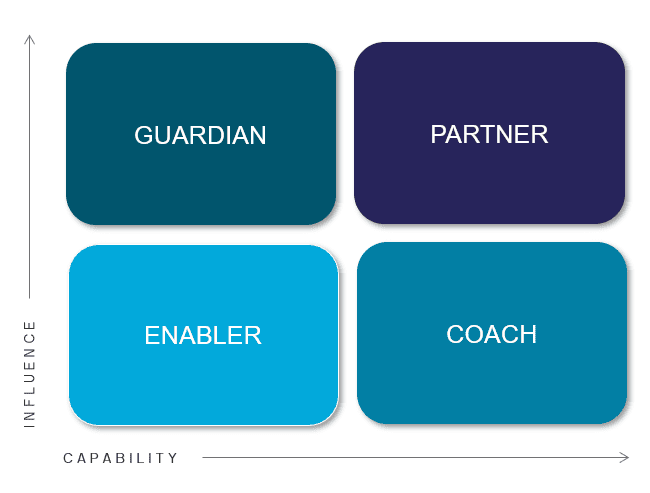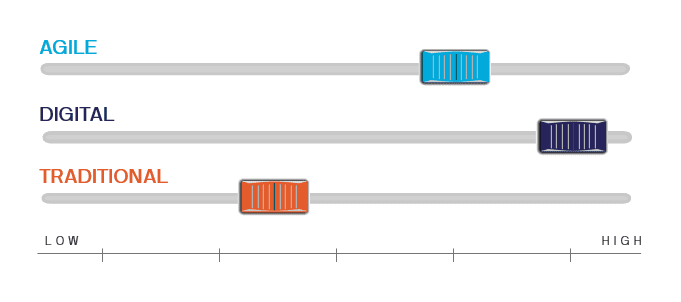Our website is not supported on this browser
The browser you are using (Internet Explorer) cannot display our content.
Please come back on a more recent browser to have the best experience possible

Your guide to the Project Management Office
If you are in project management you have likely come across the term PMO. It stands for Project Management Office. Odds are your organization already has one in place, as nearly 75% of organizations now do. As specialists in PMO setup and delivery for the past 30 years, we at MIGSO-PCUBED know that there is a difference between just having a PMO and having a great one. This guide is aimed at ensuring your project management office is the latter of the two.
A PMO, or Project Management Office, is defined as a group that exists to support the delivery of an organization’s business goals through project portfolio management.
It is responsible for coordinating, and oftentimes leading activities across a portfolio of projects and programs, communicating on status to all of its key stakeholders.

As highlighted above, a PMO is a group that plays a critical part in driving successful program and project delivery across an organization. It ensures that the required level of planning, project controls, and quality checks are in place. It also drives visibility into program and project performance, enabling executives and team members to more effectively control and achieve the desired outcomes.
In short, a successful Project Management Office helps organizations to:
All of this leads to fewer failed projects and increased customer satisfaction.
If a PMO is so important, then why do so many of them feel unhelpful and unsuccessful?
The number one reason that most fail is due to mismatched expectations. This is due in part to a misunderstanding of the many roles that a Project Management Office can play in an organization.
Additional reasons include:
It also is due to the ever-changing landscape of project management today.
Let’s walk through the roles and responsibilities of a PMO to better understand how to drive successful project and program delivery.
A PMO plays several roles in managing projects. It can also serve many functions within the organization, but this comes down to what level it sits in the organization. First, let’s take a look at the project level.

Common functions include the development of project schedules, issue and risk management, status updates, and regular reporting against established key performance indicators (KPIs). While there are many different types and roles, it’s important to note that the ultimate goal of any good PMO is to deliver its projects successfully.
As there are many different types of organizations, there are equally as many different types of PMO. They may be differentiated on the level at which they operate within the organization. As such, they could be established to drive at the project level, the program level, or increasingly now at the portfolio level. Or depending on the scale of the business, they could be assigned to support at an Enterprise level – sometimes referred to as a Center of Excellence – business unit, or departmental.
Finally, because we like to be thorough, your PMO could be set up to operate on a stand-alone basis, focusing on the more effective management of a single large-scale transformation, like with enterprise-wide application deployments or agility PMOs.
Going back to mismatched expectations being the number 1 reason for failure, it’s important to clarify not only where the PMO sits within the organization, but also the role it is intended to play.
The role played is dependent upon the needs and maturity of the organization. We at MIGSO-PCUBED typically see one of these four different personalities within client organizations:

The Enabler Role, similar to a supportive role, is your one-stop-shop for best practice methodology and program data. If your pain point is lack of visibility of program status, you may wish to focus your attention here.
The Coach Role focuses on increased capability throughout the project teams by embedding best practices and transferring skills. So if you are looking to improve the quality of project delivery within your teams, this is the personality for you.
The Guardian Role is led by management by facts, serving as an early warning to key stakeholders. In the first role the pain point was lack of visibility. As you improve in maturity the challenge moves from pure transparency to what to do with that information; i.e. using analytics to drive insights and executive decision making.
Finally, the Partner Role focuses on pivoting to the needs of the organization according to strategy. As the project management organization has matured over time, the team is able to combine the best of each of the other roles – lean best practices, coaching skills and data to make decisions – to continue to drive successful delivery within the business.
Looking at all the various levels and roles of the project management office, it is easy to get overwhelmed or not know where to start. Its core function – i.e. what it does – is dependent upon both the level at which it sits in the organization and the role it was defined to play.
Typical responsibilities can range from providing simple project management support, to leading projects, or even leasing out project managers to teams for their duration.
Therefore, when first implementing a PMO we recommend narrowing down the focus to a few key areas namely:
This allows you to first establish the basics for improved delivery. With that as a baseline, you can then define a roadmap for continuous improvement.
The PMO has been transformed over the past few years into a value driver. The trends faced by project management offices going into 2020 were:
As project management offices upskilled their staff, realigned themselves to the strategic objectives of the organization and supported the transition to newer ways of working, the PMO saw its credibility and stock rise within the business.
Of course, 2020 was dominated by the outbreak of the novel coronavirus and companies worldwide transitioned to working remotely overnight. Many organizations turned to their PMOs to help them structure and lead their COVID-19 recovery and compliance programs.
Those that heavily invested in collaboration technologies were able to make the transition to Remote Services most seamlessly, while others took months to wade through the challenges.
While these trends all still remain to be true, going forward the Project Management Office of the Future will need to be Hybrid. In each sense of the word.
They will need to be able to adapt their ways of working to accommodate both remote and in-person stakeholders. They will also need to adapt their management processes to accommodate both traditional and more adaptive ways of working like Agile.
Gone are the days when you had the luxury of being one thing. You Project Management Office could be either Agile or Traditional, or even Digital. Though if we are being honest, we think all PMOs are digital going forward.

It’s therefore probably best to think along the lines of a dial or slider. How digital do we need to be within this organization in order to increase visibility of status? How Agile do we need to be in order to increase confidence in delivery? How traditional do we need to be in order to ensure compliance to regulatory requirements? Essentially, do we need to turn up the volume or turn it down to get the team to perform the best?
We see the trend of the PMO being the driver of increasing capability and value delivery within the organization. Does your Project Management Office do this for your organization?
“An effective PMO will be at the heart of any project or program, and will act as a key enabler to its success.”
Today our environment is more project oriented than ever. Those seeking to deliver more value must improve on their ability to deliver on their projects and programs. For more than 25 years, we have worked with some of the largest organizations delivering PMO and project management consulting services,
to help them to successfully manage their projects and programs.
We combine our expertise with a fine knowledge of the industry to deliver high-value project management services.
MIGSO-PCUBED is part of the ALTEN group.
Find us around the world
Australia – Canada – France – Germany – Italy – Mexico – The Netherlands – Portugal – Romania – South East Asia – Spain – Switzerland – United Kingdom – United States
© 2024 MIGSO-PCUBED. All rights reserved | Legal information | Privacy Policy | Cookie Settings | Intranet
Perfect jobs also result from great environments : the team, its culture and energy.
So tell us more about you : who you are, your project, your ambitions,
and let’s find your next step together.
Dear candidates, please note that you will only be contacted via email from the following domain: migso-pcubed.com. Please remain vigilant and ensure that you interact exclusively with our official websites. The MIGSO-PCUBED Team
Choose your language
Our website is not supported on this browser
The browser you are using (Internet Explorer) cannot display our content.
Please come back on a more recent browser to have the best experience possible
